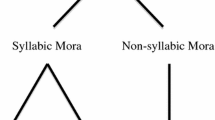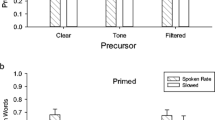Abstract
Speech errors are generally said to accommodate to their new phonological context. This accommodation has been validated by several transcription studies. The transcription methodology is not the best choice for detecting errors at this level, however, as this type of error can be difficult to perceive. This paper presents an acoustic analysis of speech errors that uncovers non-accommodated or mismatch errors. A mismatch error is a sub-phonemic error that results in an incorrect surface phonology. This type of error could arise during the processing of phonological rules or they could be made at the motor level of implementation. The results of this work have important implications for both experimental and theoretical research. For experimentalists, it validates the tools used for error induction and the acoustic determination of errors free of the perceptual bias. For theorists, this methodology can be used to test the nature of the processes proposed in language production.




Similar content being viewed by others
Notes
This rule could also be formulated as vowel shortening before a voiceless coda.
This procedure was adapted from Goldrick and Blumstein (2006).
References
Baars, B. J., & Motley, M. T. (1974). Spoonerisms: Experimental elicitation of human speech errors. Abstract in Catalogue of Selected Documents in Psychology, 4, 118.
Berg, T. (1987). The case against accommodation: Evidence from German speech error data. Journal of Memory and Language, 26, 277–299.
Boersma, P., & Weenink, D. (2006). Praat: Doing phonetics by computer (Version 4.4.33) [Computer software]. Retrieved 5 Oct 2006, from http://www.praat.org
Boomer, D., & Laver, J. (1968). Slips of the tongue. British Journal of Disorders of Communication, 3, 1–12.
Cohen, J., MacWhinney, B., Flatt, M., & Provost, J. (1993). PsyScope: A new graphic interactive environment for designing psychology experiments. Behavioral Research Methods, Instruments, and Computers, 25, 257–271.
Dell, G. S. (1986). A spreading-activation theory of retrieval in sentence production. Psychological Review, 93, 283–321.
Dell, G. S., Burger, L. K., & Svec, W. R. (1997). Language production and serial order: A functional analysis and a model. Psychological Review, 104, 123–47.
Frisch, S. A., & Wright, R. (2002). The phonetics of phonological speech errors: An acoustic analysis of slips of the tongue. Journal of Phonetics, 30, 139–162.
Fromkin, V. A. (1971). The non-anomalous nature of anomalous utterances. In V. A. Fromkin (Ed.), Speech errors as linguistic evidence (pp. 215–69). The Hague: Mouton.
Fromkin, V. A. (Ed.). (1973). Speech errors as linguistic evidence. The Hague: Mouton.
Fromkins Speech Error Database. (2000). Max Planck Institute for Psycholinguistics. The Netherlands: Nijmegen.
Garrett, M. F. (1975). The analysis of sentence production. In G. H. Bower (Ed.), The psychology of learning and motivation (Vol. 1, pp. 133–177). New York: Academic Press.
Goldrick, M., & Blumstein, S. E. (2006). Cascading activation from phonological planning to articulatory processes: Evidence from tongue twisters. Language and Cognitive Processes, 21, 649–683.
Goldstein, L. (1980). Bias and asymmetry in speech perception. In V. A. Fromkin (Ed.), Errors in linguistic performance: Slips of the tongue, ear, pen, and hand (pp. 241–261). San Francisco: Academic Press.
Gormley, A., & Thomson, R. (2007). Phonetic features are anticipatory. In D. S. McNamara & J. G. Trafton (Eds.), Proceedings of the 29th annual cognitive science society (p. 1763). Austin, TX: Cognitive Science Society.
Guest, D. J. (2002). Phonetic features in language production: An experimental examination of phonetic feature errors. Unpublished doctoral dissertation, University of Illinois at Urbana-Champaign.
Haggard, M. (1978). The devoicing of voiced fricatives. Journal of Phonetics, 6, 95–102.
Kenstowicz, M., & Kisseberth, C. (1979). Generative phonology: Description and theory. San Diego, CA: Academic Press.
Levelt, W. J. M. (1989). Speaking: From intention to articulation. Cambridge, MA: MIT Press.
Levelt, W. J. M. (1993). Timing in speech production with special reference to word from encoding. Annals of the New York Academy of Sciences, 682, 283–295.
MacKay, D. G. (1970). Spoonerisms: The structure of errors in the serial order of speech. Neuropsychologia, 8, 323–350.
MacKay, D. G. (1972). The structure of words and syllables: Evidence from errors in speech. Cognitive Psychology, 3, 210–227.
Meringer, R., & Mayer, K. (1896). Versprechen und Verlesen. Stuttgart: Goschen.
Motley, M. T., & Baars, B. J. (1976). Laboratory induction of verbal slips: A new method for psycholinguistic research. Communication Quarterly, 24, 28–34.
Mowrey, R. A., & MacKay, I. R. A. (1990). Phonological primitives: Electromyographic speech error evidence. The Journal of the Acoustical Society of America, 88, 1299.
Pouplier, M. (2003). Units of phonological encoding: Empirical evidence. Unpublished doctoral dissertation. New Haven, CT: Yale University.
Shattuck-Hufnagel, S. (1979). Speech errors as evidence for a serial ordering mechanism in sentence production. In W. E. Cooper & E. C. T. Walker (Eds.), Sentence processing: Psycholinguistic studies presented to Merrill Garrett (pp. 295–342). Hillsdale, NJ: Erlbaum.
Shattuck-Hufnagel, S. (1983). Sublexical units and suprasegmental structure in speech production planning. In P. F. MacNeilage (Ed.), The production of speech (pp. 109–136). New York: Springer.
Smith, C. L. (1997). The devoicing of /z/ in American English: Effects of local and prosodic context. Journal of Phonetics, 25, 471–500.
Stemberger, J. P. (1982). The nature of segments in the lexicon: Evidence from speech errors. Lingua, 56, 235–259.
Stemberger, J. P. (1983). Speech errors and theoretical phonology: A review. Bloomington: Indiana University Linguistics Club.
Stemberger, J. P. (1992). The reliability and replicability of naturalistic speech error data: A comparison with experimentally induced errors. In B. J. Baars (Ed.), Experimental slips and human error: Exploring the architecture of volition (pp. 195–215). New York: Plenum Press.
Wilshire, C. E. (1999). The “tongue twister” paradigm as a technique for studying phonological encoding. Language and Speech, 42, 57–82.
Author information
Authors and Affiliations
Corresponding author
Appendix
Appendix
Stimuli used for tongue twisters
a. Control condition (non-alternating, AAAA) | |||
|---|---|---|---|
tiff tiff tiff tiff | teff teff teff teff | taff taff taff taff | tuff tuff tuff tuff |
tiss tiss tiss tiss | tess tess tess tess | tass tass tass tass | tuss tuss tuss tuss |
tivv tivv tivv tivv | tevv tevv tevv tevv | tavv tavv tavv tavv | tuvv tuvv tuvv tuvv |
tizz tizz tizz tizz | tezz tezz tezz tezz | tazz tazz tazz tazz | tuzz tuzz tuzz tuzz |
kiff kiff kiff kiff | keff keff keff keff | kaff kaff kaff kaff | kuff kuff kuff kuff |
kiss kiss kiss kiss | kess kess kess kess | kass kass kass kass | kuss kuss kuss kuss |
kivv kivv kivv kivv | kevv kevv kevv kevv | kavv kavv kavv kavv | kuvv kuvv kuvv kuvv |
kizz kizz kizz kizz | kezz kezz kezz kezz | kazz kazz kazz kazz | kuzz kuzz kuzz kuzz |
b. Experimental condition (alternating, ABBA) | |||
|---|---|---|---|
tiff tivv tivv tiff | teff tevv tevv teff | taff tavv tavv taff | tuff tuvv tuvv tuff |
tiss tizz tizz tiss | tess tezz tezz tess | tass tazz tazz tass | tuss tuzz tuzz tuss |
kiff kivv kivv kiff | keff kevv kevv keff | kaff kavv kavv kaff | kuff kuvv kuvv kuff |
kiss kizz kizz kiss | kess kezz kezz kess | kass kazz kazz kass | kuss kuzz kuzz kuss |
tivv tiff tiff tivv | tevv teff teff tevv | tavv taff taff tavv | tuvv tuff tuff tuvv |
tizz tiss tiss tizz | tezz tess tess tezz | tazz tass tass tazz | tuzz tuss tuss tuzz |
kivv kiff kiff kivv | kevv keff keff kevv | kavv kaff kaff kavv | kuvv kuff kuff kuvv |
kizz kiss kiss kizz | kezz kess kess kezz | kazz kass kass kazz | kuzz kuss kuss kuzz |
Rights and permissions
About this article
Cite this article
Gormley, A. Acoustic Evidence for Phonologically Mismatched Speech Errors. J Psycholinguist Res 44, 105–117 (2015). https://doi.org/10.1007/s10936-013-9282-2
Published:
Issue Date:
DOI: https://doi.org/10.1007/s10936-013-9282-2




